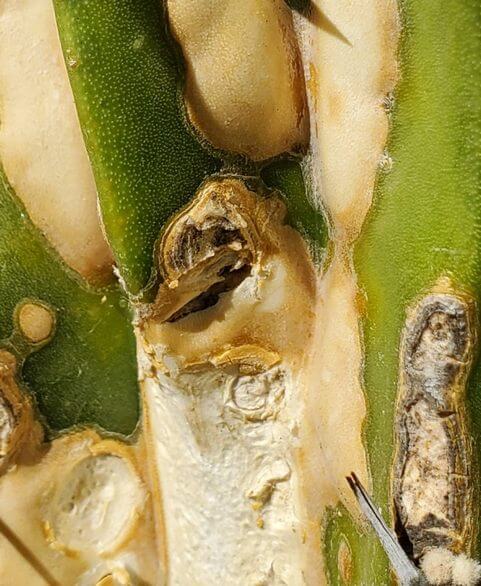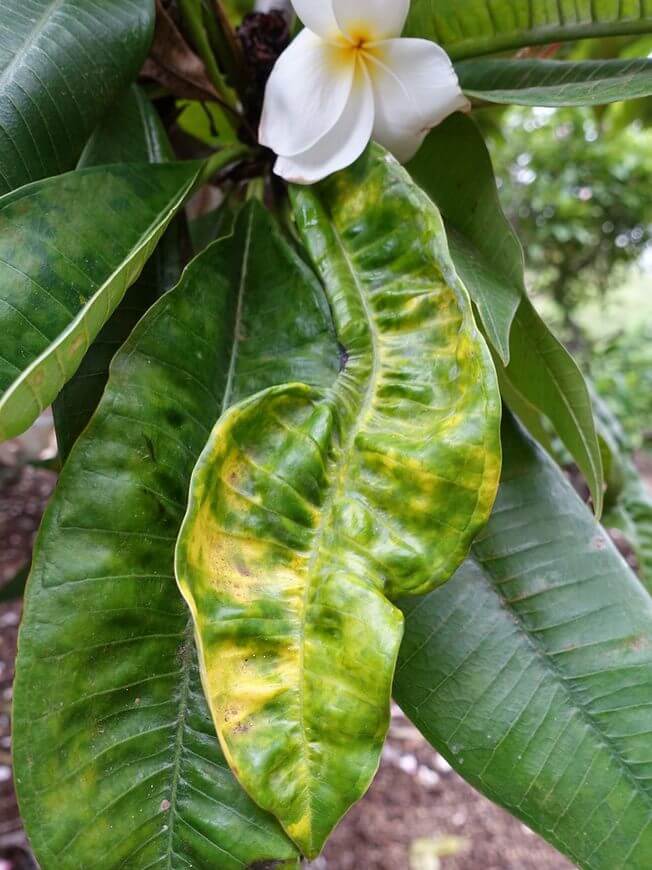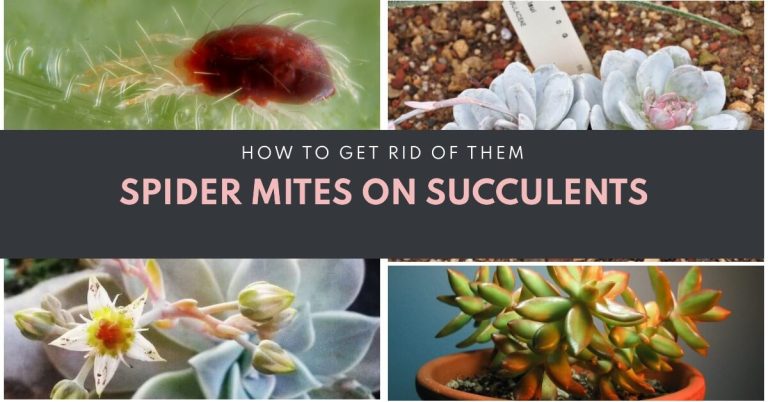What is a Mite Infestation?
Spider Mites on Succulents – Mites can be a nuisance for succulent lovers, but don’t worry – there are ways to protect your precious plants from these pesky little critters. Two-spotted spider mites cause mite infestations.
These tiny bugs feed on the sap of succulent leaves, leaving behind brown and white spots on the undersides of leaves. If left untreated, spider mites can quickly spread throughout an entire plant. Luckily, there are several ways to eliminate mite infestations on your succulents.
Some natural predators, such as predatory mites or ladybugs, can help keep spider mites away without using insecticides. Alternatively, spray infected plants with water and dish soap (one tablespoon per gallon) every few days until the pests are gone.
Lastly, maintain dry conditions around your succulents, as this will reduce the chances of future infestations occurring in the first place!
Signs of Spider Mites on Succulents
It’s always heartbreaking when your beloved succulents are infested with spider mites. These tiny creatures can be extremely difficult to spot, but there are some tell-tale signs that you should watch out for.
The most common sign is brown spots on the leaves – these correspond to where the mites have been feeding. You may also notice a web-like substance between the stems and branches of your plant, which is another indication of a spider mite infestation.
Lastly, if you can see any small bugs crawling around on your plants, they’re almost certainly spider mites. So be sure to check your succulent collection regularly for any of these signs – catching an infestation early will make eliminating it much easier!
Brown Spots
Brown spots can be a tell-tale sign of spider mite infestation on your beloved succulents. These nasty little creatures are difficult to spot, but the brown spots they leave behind on the leaves are a dead giveaway that it’s time to take action!
If you notice discoloration, it’s important to act quickly – the sooner you address the issue, the better your chance of saving your precious plants.
One natural way to rid your succulent of spider mites is by using insecticidal soaps – mix a few drops of soap with water and spray onto the entire plant, including the undersides of leaves.
If your succulent is exposed to dry conditions or too much direct sunlight, this could also lead to an outbreak of spider mites – so be sure to watch for white spots in these areas. You can keep your plant collection safe from these pesky pests with vigilance and care!

White Spots
White Spots on Succulents – Don’t Panic!
If you’ve noticed some white spots on your succulent, don’t panic. These little specks could signify the two-spotted spider mite – one of the most common pests to plague indoor plants.
Thankfully, however, there are steps you can take to protect your beloved succulent from this pesky pest. Firstly, ensure that your plant gets enough water and keep it away from direct sunlight or dry conditions, making it the ideal environment for these critters.
Secondly, use insecticidal soap to spray onto both sides of the leaves to kill off any mites that may have already taken up residence. Finally, why not introduce some natural predators into the mix? Predatory mites such as Phytoseiulus persimilis will happily feast on their two-spotted cousins and help keep them at bay!
Webbing Between Leaves and Stems
Webs Between Leaves and Stems – Not Just for Spiders!
If you’ve noticed a light webbing between your succulent leaves and stems, don’t be so quick to assume that an eight-legged arachnid has spun into your home.
While spiders can certainly cause these webs, it’s more likely that you have an infestation of spider mites. These tiny pests are notorious for feeding on plant sap and leaving signs such as brown spots, yellowing leaves, and discoloration.
The good news is that this problem can be easily solved if caught early: mix a few drops of liquid dish soap with water and spray the entire plant – including the undersides of the leaves – with this mixture. You’ll soon see your precious plants return to their former glory with regular treatment!
Curling of Leaves and Stems
Gently Curl Away!
Suppose your beloved succulent plants are exhibiting signs of curling leaves and stems. Fear not! While it’s possible that this could be caused by harmful insects like spider mites, more likely than not, it’s just a sign of dry conditions.
Succulents thrive in direct sunlight and need regular watering – so make sure to give your plant collection the care and attention they deserve. If the problem persists, you can introduce natural predators into the soil, such as predatory mites or ladybugs.
Or, if you’re feeling particularly brave, you can tackle the infestation with insecticidal soaps, which are available at most garden supply stores. Mix a few drops with water and spray generously over both sides of the leaves. With a bit of TLC, those pesky pests should soon curl away into oblivion!

Causes of Spider Mites on Succulent Plants
Ahoy, succulent lovers! If your precious plants show signs of spider mite infestation, it’s time to act. Spider mites are a common pest found on indoor and outdoor plants, and they can cause extensive damage if left unchecked. You’ll know you have them when you start seeing brown or white spots on the undersides of leaves – yikes!
Fortunately, there are some simple measures you can take to get rid of these pesky critters. Start by gently washing your plant with water and a few drops of mild dish soap; this will help eliminate any existing mites as well as eggs that may be present. Then introduce natural predators like predatory mites or ladybugs into the soil to keep future populations at bay. Finally, if all else fails, you can use insecticidal soaps available in most garden centers.
So get ready for battle – those two-spotted spider mites won’t know what hit them! With some elbow grease and determination, you’ll soon have your beloved succulents back in prime condition again.
Dry Conditions
Ah, succulent lovers – have you ever had the misfortune of seeing your beloved plants wilt in dry conditions? Let’s face it: if your succulents are looking a bit worse for wear, chances are they’re not getting enough water. But don’t panic just yet! The good news is that dry conditions can be remedied with simple steps.
For starters, make sure to water your succulents regularly but sparingly – after all, too much moisture can be just as bad as too little. Check the soil before watering; you’re good to go if it feels damp or cool. Additionally, consider moving your plants away from direct sunlight and into an area with better air circulation. This will help ensure moisture isn’t evaporating too quickly from their leaves.
Finally, don’t forget that every plant has unique needs – so get to know yours! Regular observation and care will go a long way toward keeping your succulents happy and healthy.
Direct Sunlight
If you’re a succulent lover, you know that direct sunlight can be your plants’ worst enemy. Too much heat and UV light can cause sunburns, leading to discoloration or even death in extreme cases. To prevent this from happening, place your succulents in an area with partial shade or filtered light. You may also want to consider rotating your plants every few days so that only one side of the plant is exposed to the sun at any given time.
Though succulents are usually drought tolerant, too much direct sunlight can also cause them to dry out quickly. If you observe that your plants are wilting or turning yellow despite being watered regularly, it may be due to excessive heat exposure.
Moving them away from direct sunlight into a shadier area should help relieve the stress on their leaves and stems – but remember not to overdo it! Succulents need some sunshine to thrive, so don’t forget the importance of keeping them properly hydrated.
Overcrowding in Plant Collection
Overcrowding in plant collections is a common mistake for novice gardeners. After all, it’s easy to get carried away when presented with so many beautiful succulent plants. But overcrowding can cause problems, as the plants will fight for space and resources. This can lead to wilting, or even death as some of your beloved plants are left without enough light or water.
To prevent this from happening, make sure that each of your succulent plants has plenty of room to grow and thrive. Arrange them at least six inches apart, and watch for any signs of overcrowding, such as stunted growth or brown spots on the leaves. If you notice any of these issues, it may be time to thin out your collection or find a bigger pot for your precious plants!
It’s also important to remember that succulents need lots of light to stay healthy. Placing them too close together can block sunlight from reaching the underside of leaves, leading to yellowing or white spots appearing on the surface – a sure sign that something isn’t right! So don’t forget: give your succulents enough space, and they’ll reward you with vibrant colors and lush foliage!
Prevention of Spider Mites on Succulents
Spider mites on succulents can be a real pain in the cactus! But with the right steps, you can keep these pesky pests away from your precious plants. Proper watering is essential for keeping spider mites at bay.
Make sure to give your succulents enough water, but don’t overdo it—succulents don’t like too much moisture. Additionally, providing adequate airflow to your plant is key; this helps keep spider mites away and prevents infections from spreading. Finally, make sure to check regularly for signs of infestation.
Spider mites are small and easy to miss. Still, if caught early enough, you can use insecticidal soaps or predatory mites to eliminate the problem without damaging your beloved succulents!
Treatments for a Spider Mite Infestation on Succulents
Treating a spider mite infestation on your succulents can seem daunting, but with the right steps, you can quickly get your plant back to its healthy self!
The first step is to remove any infected parts of the plant. This will help reduce the spread of the mites and give you a better idea of how severe the infestation is.
Next, you can use insecticidal soaps or washings with dish soap to kill off any existing mites. You can also apply predatory mites directly to affected areas; these useful critters feed on spider mites and are a great organic way to contain an infestation without harming your plants.
Finally, if conditions are too dry for your succulents, try increasing humidity around them, making it harder for spider mites to survive in their environment. With these tips, you’ll be able to get rid of those pesky pests and save your beloved plants!
How to Avoid Future Outbreaks of Spider Mites on Succulents
Ensuring Proper Care and Maintenance Regularly Inspecting Your Precious Plants Separating Infected Plants from Your Beloved Plants
Avoiding future outbreaks of spider mites on your precious succulents is key to keeping them healthy and beautiful. Proper care and maintenance are the best defense against these pesky pests, so ensure you provide your succulents with enough direct sunlight, water, and humidity.
Inspect your plants regularly and look for signs of spider mites, such as brown spots or white spots on the undersides of leaves. Immediately separate the infected plant from your other beloved plants if you notice an outbreak to prevent further spread. You can also try adding drops of dish soap or insecticidal soap to a spray bottle filled with water, then use it to spray any affected areas. With these tips in mind, you’ll be able to enjoy a pest-free collection of succulents!
Conclusion
In conclusion, spider mites can be a pesky problem for succulent owners. To prevent future outbreaks, it’s important to provide your plants with plenty of sunlight, humidity, and water.
Regularly inspect your succulents for signs of infection and separate any affected plants from the rest of your collection. If you find an outbreak, try using insecticidal soaps to help eradicate them. With these tips in mind, you’ll be able to enjoy having a pest-free plant family!
